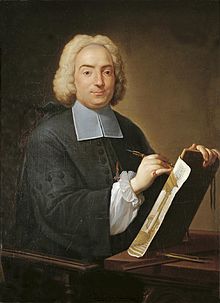Filippo Juvarra
| Filippo Juvarra | |
|---|---|

Filippo Juvarra (c.1707), by Agostino Masucci (Real Academia de Bellas Artes de San Fernando, Madrid)
|
|
| Born | 7 March 1678 Messina |
| Died | 31 January 1736 (aged 57) Madrid |
| Nationality | Italian |
| Known for | Architecture |
| Movement | Baroque |
Filippo Juvarra (7 March, 1678 – 31 January 1736) was an Italian architect and stage set designer, active in a late-Baroque style.
He was born in Messina, Sicily, to a family of goldsmiths and engravers. After spending his formative years with his family in Sicily where he designed Messina's festive settings for the coronation of Philip V of Spain and Sicily (1705), Juvarra moved to Rome in 1704. There he studied architecture with Carlo and Francesco Fontana.
The first phase of his independent career was occupied with designs for ceremonies and celebrations, and especially with set designs for theatres. Juvarra's set designs incorporate the scena per angolo, literally 'scenes at an angle.' The exact origin of this style is unclear. Ferdinando Galli Bibiena claims to have invented it in his treatise Architettura Civile (1711). However, the style was clearly in use before then, including in the works of Juvarra. This style differed from the one-point perspective sets that had been developed in the sixteenth century and had reached their apogee in the seventeenth century; see, for example, the work of Giacomo Torelli. A couple of early drawings by Juvarra, dated 1706, are associated with the Teatro S. Bartolomeo, Naples (1706), though whether he actually completed the set designs for the theatre is unknown. The majority of his work in theatre and set design was in Rome under the patronage of Cardinal Ottoboni. He assisted in the rebuilding of the Cardinal's private theatre in the Palazzo della Cancelleria and also designed sets for operas performed within the theatre. The first opera for which Juvarra designed all the sets was Costantino Pio. The libretto was by Cardinal Ottoboni and the music was by Carlo Francesco Pollarolli (c.1653–1723). The opera was premiered in 1709 and was one of the first operas to appear after the lifting of papal bans on secular theatre; it also inaugurated Ottoboni’s newly renovated private theatre. He also worked on set designs for performances sponsored by Ottoboni at the Teatro Capranica. His other main patron in Rome was Queen Maria Casimira, the widowed Queen of Poland, for whom Juvarra produced set designs for the operas performed in her small domestic theatre in the Palazzo Zuccari. In 1713 a theatre project took him to Genoa.
...
Wikipedia
